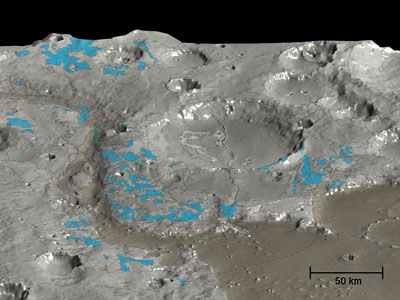MARSIS completely deployed
Posted on 11/05/2007 10:26:46 AM PST by SunkenCiv
The Medusae Fossae Formation (MFF) are unique deposits on Mars... Found near the equator, along the divide between the highlands and lowlands, they may represent some of the youngest deposits on the surface of the planet. This is inferred from the marked lack of impact craters dotting this terrain, unlike on older terrain... For the first time, these radar soundings revealed the depth of the MFF layers, because of the time it took for the radar beam to pass through the top layers and bounce off the solid rock beneath... The MFF deposits intrigue scientists because they are associated with regions that absorb certain wavelengths of Earth-based radar. This had led to them being called 'stealth' regions because they give no radar echo... Firstly, they could be volcanic ash deposits from now-buried vents or other nearby volcanoes. Second, they could be deposits of wind-blown materials eroded from other martian rocks. Thirdly, they could be ice-rich deposits, somewhat similar to the layered ice deposits at the poles of the planet, but formed when the spin axis of Mars tilts over, making the equatorial region colder... although the electrical properties are consistent with water ice layers, there is no other strong evidence for the presence of ice today in the equatorial regions of Mars... the water vapour pressure on Mars is so low that any ice near the surface would quickly evaporate.
(Excerpt) Read more at esa.int ...
blam, the “fluffy” stuff brought to mind the fluffy comet impact discussed in “Cycles of Cosmic Catastrophes”.
Red Planet’s Ancient Equator Located
Scientific American (online) | April 20, 2005 | Sarah Graham
Posted on 04/24/2005 11:18:25 PM EDT by SunkenCiv
http://www.freerepublic.com/focus/f-chat/1390424/posts
‘Pack ice’ suggests frozen sea on Mars
New Scientist | 2/21/05 | Kelly Young
Posted on 05/23/2005 10:15:45 AM EDT by RockinRight
http://www.freerepublic.com/focus/f-news/1408665/posts
Immense ice deposits found at south pole of Mars
Reuters via Yahoo! | 3-16-07 | Will Dunham
Posted on 03/15/2007 4:01:58 PM EDT by Pharmboy
http://www.freerepublic.com/focus/f-news/1801465/posts
:’) Another good reason to postpone indefinitely a human mission to Mars.
Aye.
I enlarged the ‘Topographic divide between the Martian highlands and lowlands’ graphic shown in the article - looks like an ocean bed to me...sediment maybe?
Yea, being a former ocean bed would explain the lack of impact craters.
One large impact event (comprised of many impacting objects or ejecta (or both) may have had something to do with it.
Recent evolution of water-ice at the south pole of Mars
About 10 000 years ago the precession cycle was inverted, and started to return to its current configuration. Water-ice at the South Pole became unstable, and was forced to progressively return back to the North.

reminds me of something going on 'down here'
Mars is mired in a Precession? Bush’s fault.
Ten Thousand years ago...that’s like yesterday.
Maybe it was ‘in the middle of the second millenium’ BC?

In this HRSC 3D perspective view of the Marwth Vallis area (shades of grey), OMEGA has mapped the water-rich minerals (blue). No hydrated minerals or sediments have been detected, either in the channel or in its opening. However, the outflow was so violent as to erode and expose ancient hydrated clay-rich minerals, tracing an early era when water was present.
:’) Ices (including water ices) normally locked up in the soil are released by the energy of impacts large and small. Impacts large enough to do so produce a short-lived atmosphere in a limited area, which yields a temporary atmospheric pressure permitting liquid water to exist. That’s why these apparent erosion patterns exist; IMV at least some of these are old, refrozen mud flows. Regardless, this is the reason that these “rivers” appear to arise from nowhere and flow nowhere. The conditions permitting liquid water to exist dissipate as the water vapor cools back into ice and precipitates.
Huge Reservoir of Frozen Water Found on Mars
Fox News | Thursday, March 15, 2007
Posted on 03/15/2007 5:23:26 PM EDT by Sopater
http://www.freerepublic.com/focus/f-news/1801513/posts
International politics will likely drive this as it is driving the new round of lunar exploration. Japan has its lunar orbiter, China has its lunar orbiter, India intends to launch their lunar orbiter in April, even NASA has something in development along those lines.
Mars once riddled with deep waterMars was once latticed by an underground water system, scientists have reported... NASA's Martian rover, Opportunity, in its exploration of a vast sloping plain called Meridiani Planum... found sulphate-rich sediments that some experts claimed were the remains of seas that once washed over the planet. Others, though, pointed out that the site at Meridiani Planum was not a basin, and thus could not enclose such a huge amount of water... Jeffrey Andrews-Hanna and colleagues... theorise that the water has bubbled up from underground... The computer model devised by Andrews-Hanna and his colleagues extends far beyond the spot where Opportunity found the hydrated sulphate salt minerals.
Agence France-Presse
Thursday, March 8, 2007
Cosmos Magazine
Disclaimer: Opinions posted on Free Republic are those of the individual posters and do not necessarily represent the opinion of Free Republic or its management. All materials posted herein are protected by copyright law and the exemption for fair use of copyrighted works.